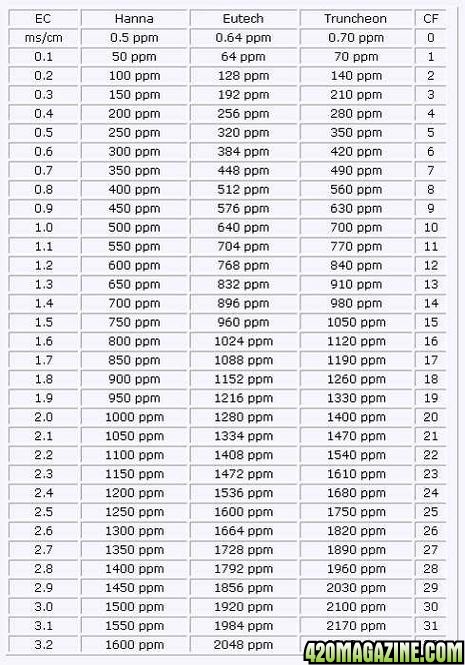Around the forums here, and any MMJ forums, people throw around "PPM (Pars Per Million)" quite a bit, but I'm not sure everyone realizes that PPM's are not standardized. An Oakton meter and a Hanna meter used to measure the same nutrient solution would report different PPM readings, for example. EC (Electrical Conductivity) is the only truly "universal" measurement standard for total disolved solids, and the PPM readings our meters give us convert that, using a math formula, to PPM's. The problem is that Hanna uses ".5" as the conversion factor, Oakton uses ".7" etc....
This chart sums it up well:

The reason I bring this up, is that I plan on running my plants at much lower PPM/EC levels than I used to, and I plan on continuing this into flower. My plants above are currently vegging at .7 EC, or 490 ppm on my Oakton meter. They are showing no signs of deficiency and are growing rapidly.
There is a grower named Heath Robinson who grows single-plant/trees yielding 40z plus per plant, indoors in hydro, using no higher than 1.2 EC in bloom. You read that right, all of it, and no I didn't mean 40 grams. This is my inspiration to run lower PPM's/EC, as I think he's more than proved his point. I took a first step in my last grow, where I rarely went above 1000 ppm on my Oakton meter, or about 750ppm on a Hanna/ 1.5 EC.
All plants are different, and have different feeding needs, so I'll need to watch my plants closely and adjust. What works for others in their environment doesn't always translate...
Sorry if this was boring, but I thought maybe someone would find all this useful -- it's what's occupying my mind at the moment!
I should note that in order to grow plants like that 40z monster, you need much more light than I have! Heath's experiences tell me that nutrient concentration is very secondary to lots and lots of light!!!
If you are interested in seeing a plant like that, Mr. Smith is growing an indoor hydro TREE out of his Dark Star mother that should easily win POTM when he enters it. Check out his excellent Dark Star thread if you get a moment:
Darkstar project - advanced growing
This chart sums it up well:

The reason I bring this up, is that I plan on running my plants at much lower PPM/EC levels than I used to, and I plan on continuing this into flower. My plants above are currently vegging at .7 EC, or 490 ppm on my Oakton meter. They are showing no signs of deficiency and are growing rapidly.
There is a grower named Heath Robinson who grows single-plant/trees yielding 40z plus per plant, indoors in hydro, using no higher than 1.2 EC in bloom. You read that right, all of it, and no I didn't mean 40 grams. This is my inspiration to run lower PPM's/EC, as I think he's more than proved his point. I took a first step in my last grow, where I rarely went above 1000 ppm on my Oakton meter, or about 750ppm on a Hanna/ 1.5 EC.
All plants are different, and have different feeding needs, so I'll need to watch my plants closely and adjust. What works for others in their environment doesn't always translate...
Sorry if this was boring, but I thought maybe someone would find all this useful -- it's what's occupying my mind at the moment!
I should note that in order to grow plants like that 40z monster, you need much more light than I have! Heath's experiences tell me that nutrient concentration is very secondary to lots and lots of light!!!
If you are interested in seeing a plant like that, Mr. Smith is growing an indoor hydro TREE out of his Dark Star mother that should easily win POTM when he enters it. Check out his excellent Dark Star thread if you get a moment:
Darkstar project - advanced growing


